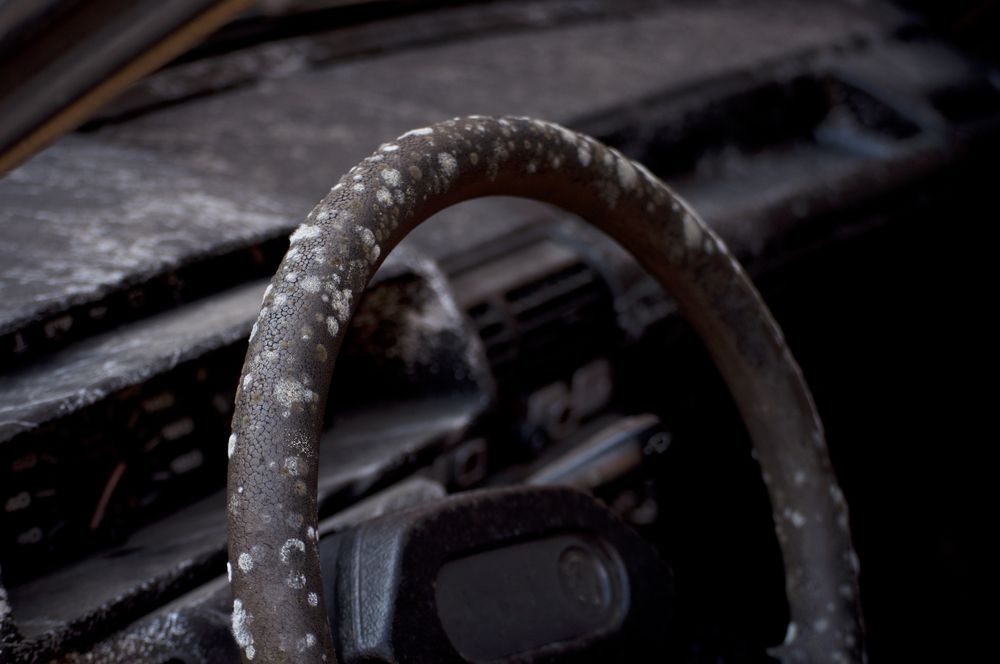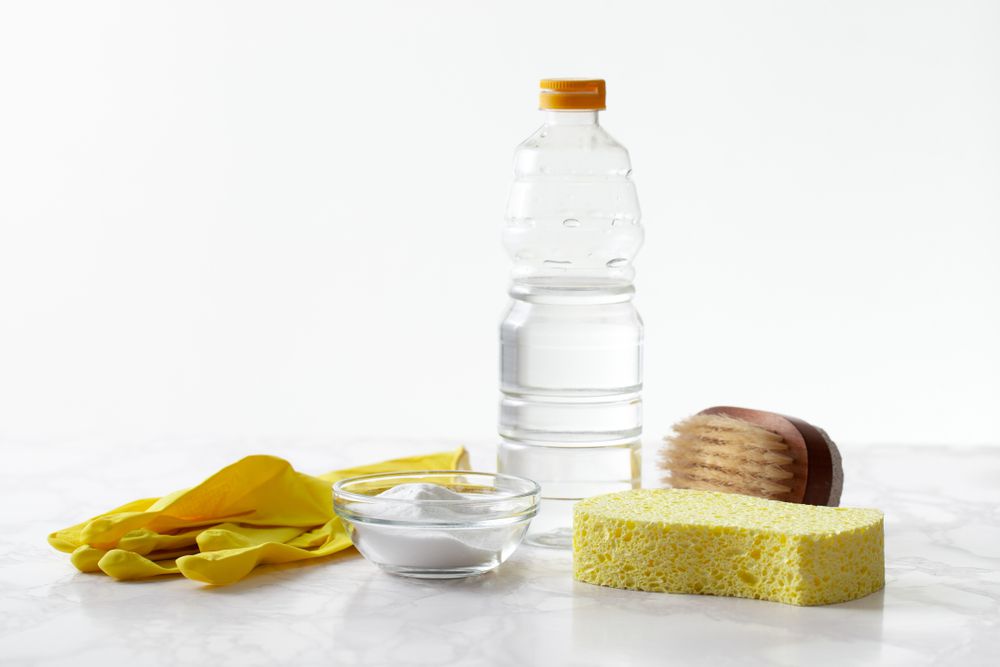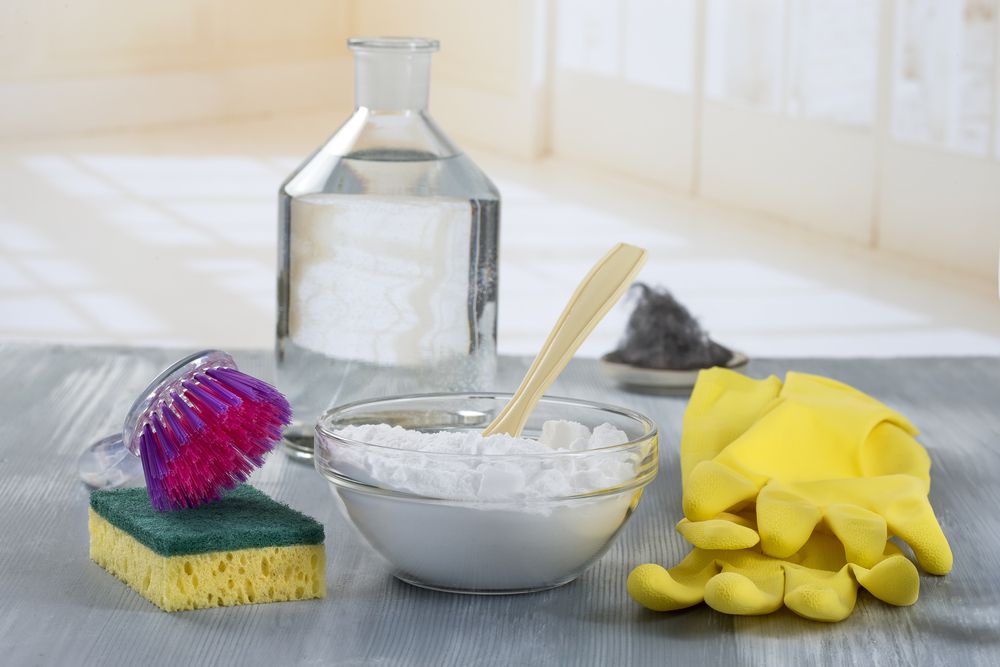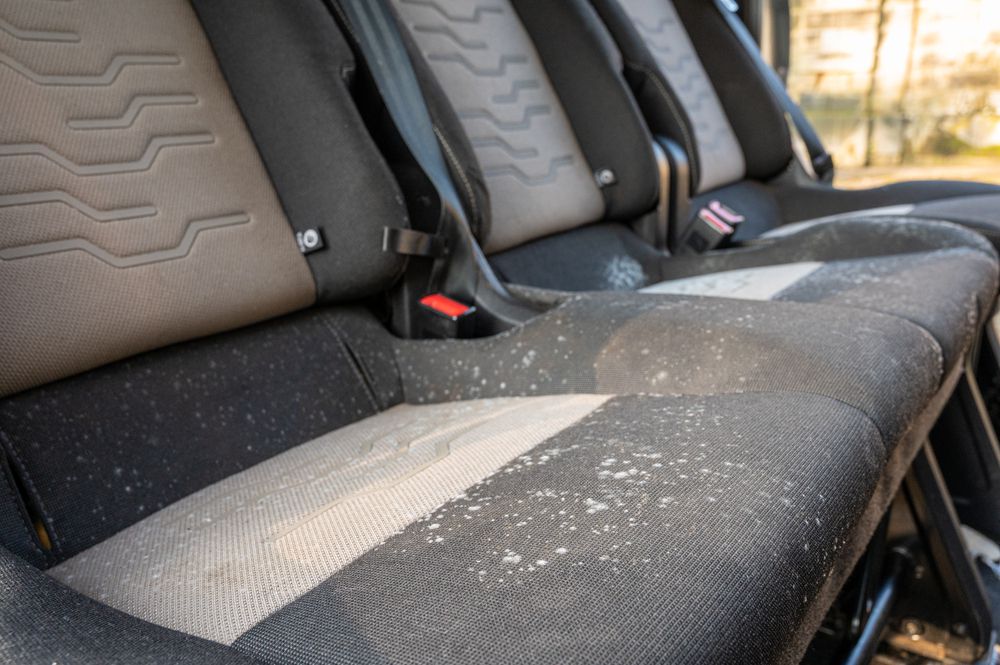Mold spores can cause ill health if exposed to them for prolonged periods.
So, it's best to learn how to remove mold before the worst happens.
You can get mold out of your car in several ways, such as using white
vinegar and a spray bottle, a non-iodized salt solution, several drops
of clove oil, or a bit of baking soda.
The ingredients clear surface mold and penetrate deeply into interior
fabrics to eliminate the root cause and prevent regrowth.
In the following sections, we'll explore the various cleaning methods, mold
growth causes, health implications, and more.
 Mold growing on a car steering wheel.
Mold growing on a car steering wheel.
How Do You Get Mold Out Of Car Fabric?
With the right equipment, ingredients, and a little bit of elbow grease,
removing mold from your car interior isn't as hard as you may think.
From white vinegar to clove oil, we go over the top mold removal solutions
below:
1) White Vinegar
Distilled white vinegar works wonders on vehicle mold.
Thanks to its acidic properties, it kills pesky mold spores and prevents
them from returning.
 Vinager can be used to clean mold.
Vinager can be used to clean mold.
It's suitable for use on different car interior surfaces like vinyl and
leather, provided you follow the recommended application instructions
below:
-
Dilute white distilled vinegar with water or use it straight for
pervasive mold growth.
-
Apply the mixture to the mold and mildew using a spray bottle or cloth.
-
Gently scrub it.
-
Leave it for around 20 minutes.
-
Finally, use a wet-and-dry vacuum cleaner to get rid of the lifted
surface mold.
The pungent vinegar smell is a significant downside to this method.
That said, it's relatively easy to eradicate by spritzing air freshener
inside your car or opening the windows to let it disperse naturally.
 Mold can be cleaned with a salt solution to remove mold.
Mold can be cleaned with a salt solution to remove mold.
2) Non-Iodized Salt
Saltwater solutions kill mold spores by dehydrating them. After all, mold
growth can't happen without excess moisture.
Here's how to use non-iodized salt to remove mold:
-
Vacuum the affected area.
-
Mix the salt into a bucket of water, ensuring it's concentrated enough.
-
Use a spray bottle or sponge to spritz/dab the salt water onto the mold
inside your car. Don't forget to apply it to the surrounding areas too.
Otherwise, you may inadvertently miss some mold spores and encourage
further growth.
-
Sit your car in direct sunlight and let the surface dry. It will leave
a powdery residue.
-
Finish using a scrub brush and water to remove the leftover crust or a
vacuum cleaner.
Like white vinegar, there's a little disadvantage to this method of
removing mold from your car — salt is pretty corrosive, potentially causing
damage to leather seat covers.
Not to mention you will have to deal with salt stains, meaning it isn't the
best way to eliminate mold, but it will work if you're out of options.
3) Clove Oil
While clove oil is typically used to relieve digestive and tooth problems,
it's a powerful antiseptic that makes it an expert at mold removal and
prevention.
The best part? You only need a few drops of clove oil (about ¼ teaspoon)
for a liter of water!
Follow the steps below to use this cleaning method:
-
Vacuum the moldy areas first.
-
Mix the clove oil solution using the ratio above.
-
Apply a small amount to the mold growth.
-
Leave it to dry.
-
Clean the area, and you've successfully removed mold from your car!
If you're suffering from extensive mold, mix clove oil with baking soda and
apply it to the area with a toothbrush.
Scrub vigorously and wipe it off when the surface dries.
 Baking soda can clean mold in your car.
Baking soda can clean mold in your car.
4) Baking Soda
Baking soda boasts exceptional cleaning properties — and its mold removal
abilities are no different.
Plus, it's a fantastic air freshener, so what's not to love?
Simply sprinkle the baking soda onto the mold in your car and leave it for
20 minutes.
This kitchen staple absorbs moisture, leaving a powder that's easily
vacuumed or wiped away.
For even more robust results, make a baking soda and vinegar solution and
use a spray bottle to apply it.
Best Mold Remover For Car Interior?
Aside from the vinegar smell, we dub white vinegar the best solution for
cleaning mold!
Just allow fresh air to circulate your car's interior by opening all the
windows before going on a road trip.
Car Detailing Mold Removal Cost?
Professional interior car cleaning services can cost anywhere from $50 to
$200 (and more), depending on the size of your vehicle.
Generally, it's worth the money if you don't have time to remove mold
yourself — and even if you do, a professional will have the perfect
machines and chemicals to get rid of the mold in your entire car properly.
 Mold on car seats.
Mold on car seats.
Signs Of Mold In Car
While it's easy to spot mold on the floor mats and other material surfaces
in your car due to the discoloration, there are other early signs of mold
growth to watch out for.
Typically, you'll discover the presence of mold due to its scent.
Often described as damp, earthy, and musty, the stench doesn't go away and
instead worsens as the mold spores continue to multiply.
Even opening your car windows won't get rid of the smell because you have
to tackle the root cause — i.e., the mold inside your vehicle.
Why Is Mold Growing In My Car?
Most car owners don't expect to see mold in their vehicles. But
unfortunately, the interior can create a perfect microclimate for fungus
growth.
Mold loves warm and moist spaces, which describes most untidy cars.
And since it's airborne, it can infiltrate the air conditioning system and
spread throughout your whole car very quickly.
You can get mold in your car in various ways, including:
-
Opening the windows in damp weather
-
High humidity
-
Leaving wet fabrics on your seats (e.g., gym bags, jackets, shoes)
-
Flooding
-
Spilling liquid on the floor mats or seats
-
Leaving your car in a damp garage
What Kind Of Mold Grows In Cars?
Depending on the species of mold in your car, it will exhibit different
colors and textures.
The most common car interior mold types are:
Green Mold
This could be Cladosporium, Aspergillus, or Penicillium.
It's normal to see this mold in your car or home.
White Mold
White mold can cause allergic reactions and other health problems if
improperly handled.
Black Mold
Despite its alarming color, not all types of black mold are innately toxic.
However, it's always best to clean it as soon as possible.
Yellow Mold
If you're exposed to yellow mold for a long time, it can pose health risks.
It's certainly one to put on your watchlist.
Is Mold In A Car Dangerous?
Mold in your vehicle can be dangerous — you aren't just risking your car's
health but your own.
 Car mold can cause a runny nose.
Car mold can cause a runny nose.
Mold spores are airborne, meaning exposure (especially over a prolonged
period) can cause rashes, infections, or allergic reactions if inhaled or
touched with bare skin.
Car mold can cause:
-
Sneezing
-
Sore throat
-
Coughing
-
Runny nose or congestion
-
Fever
-
Asthma attacks (in those who already suffer from asthma)
-
Eyes, nose, lungs, throat, or skin irritation
-
Rashes
-
Headache
-
Fever
In worst-case scenarios, exposure can lead to heart problems and eventual
death.
With that in mind, remove the fungus as soon as you see it and do your best
to prevent mold from regrowing.
How Long Does It Take For Mold To Grow In A Car?
Since cars are sealed, often warm, and don't benefit from much ventilation,
they present the perfect opportunities for lightning-fast mold growth.
Given the correct conditions, mold can grow in approximately 12 hours, and
you'll usually experience the mildew smell after a mere six to ten hours.
Does Sunlight Kill Mold In Car?
Sunlight is one of the most efficient ways to remove mold in your car!
Park your vehicle in a sunny spot, open the doors, and leave it for as long
as possible.
That said, it's best practice to tackle the mold spores using vinegar,
clove oil, or one of the other methods first and use sunlight and fresh air
afterward.
Conclusion
Salt solutions, clove oil, and baking soda are all effective ways of
removing mold.
However, distilled vinegar and a new spray bottle is arguably the best
solution, as long as you allow air to flow through your car afterward,
eliminating the acidic smell.